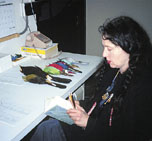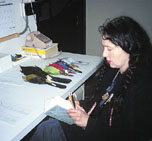

Kiki Smith’s installation asks questions. What place do scientific collections have in a museum of art? Can artists and scientists work together to interpret the meaning of collected specimens?
These questions are posed in a fascinating choreography of her own art works with bird and animal specimens from Carnegie Museum of Natural History. To open the dialogue she has divided the gallery into three rooms -- one with striking white-colored specimens, a second with her own work, and a third with beautiful multi-colored specimens, mostly of birds. This exhibition proves again that she is among the most poetic of installation artists.

Lately, in response to a growing interest in nature’s ecosystems, Smith has reformatted her earlier, human-centric concerns for the body into a wider, more animal-centric contemplation of human responsibility within the narratives of nature. For years her work summoned blunt manifestations of the human body to reveal the functional secrets of skin, orifices, glands, guts and fluids. Memorable works include casts of entire human digestive tracts, paper constructions of what look to be flayed skins, and morose yet beautiful representations of heads, ears, and hands built from materials ranging from paper to bronze. Over time she has built and exhibited a sculptural collection of bodies and body parts from which to simultaneously pick at and glean insight into the human condition. She is also known for the feminist politics inherent in her work.
Now, at Carnegie Museums, she has studied the "prepared" specimens of the natural history scientists. Steadied by a trained detachment in viewing the material, and armed with stories about scientific collecting, she uses the Forum Gallery to present these museum topics to a larger audience.
Smith’s recent work around nature has led to the production of an entirely new personal vocabulary of forms. To date these new works have primarily featured birds. For another Pittsburgh-based show, currently on exhibit at the Mattress Factory, she represents common Pennsylvania birds (e.g., blue jays, great-horned owls, robins and northern flickers) and their eggs in the form of silk-screen drawings, or bronze life-like sculptures.
Now, at the Forum Gallery she has replaced the familiar, such as Pennsylvania birds, with something unfamiliar, conceptual, and slightly exotic: a comparative study of plain white animals with animals resplendent with color. The specimens were chosen for their resemblance to the colors of the rainbow. Nestled in the room between the two types of specimens is a set of neon rainbows of her own devising. By supplanting bird sculptures with actual bird and mammal skins, she lets viewers focus on the aesthetic qualities of animals that were used for scientific research.
Kiki Smith is a museum detective of sorts. She is the exposer of museum secrets: such as the existence of beauty in the collections, and the dispassionate death of animals to serve science. The installation also shows the willingness of professional museum scientists to provide access to the secrets and charms of their materials. In this work the inanimate objects mingle in a visual conversation that is neither purely about art nor purely about science, yet capable of including both.
Jon Dunn is an artist who lives in Pittsburgh.
Contents |
Highlights |
Calendar |
Back Issues |
Museums |